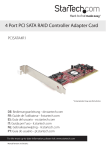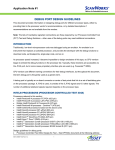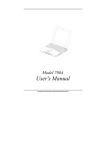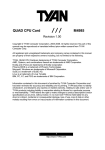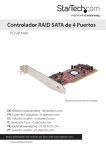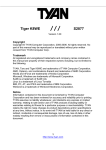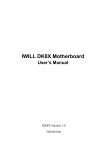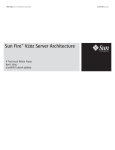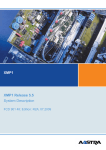Download 321 Studios SIEMENS D1692-BXX User's Manual
Transcript
answers 2 Technical Manual Mainboard D1692-Bxx English Are there ... ... any technical problems or other questions you need clarified? Please contact: • your sales partner • your sales outlet The latest information and updates (e. g. BIOS update) on our mainboards can be found on the Internet under: http://www.fujitsu-siemens.com Dieses Handbuch wurde auf Recycling-Papier gedruckt. This manual has been printed on recycled paper. Ce manuel est imprimé sur du papier recyclé. Este manual ha sido impreso sobre papel reciclado. Questo manuale è stato stampato su carta da riciclaggio. Denna handbok är tryckt på recyclingpapper. Dit handboek werd op recycling-papier gedrukt. Herausgegeben von/Published by Fujitsu Siemens Computers GmbH Bestell-Nr./Order No.: A26361-D1692-Z121-1-7619 Printed in the Federal Republic of Germany AG 0504 05/04 Ausgabe/Edition 1 A26361-D1692-Z121-1-7619 English Mainboard D1692Bxx Technical Manual May 2004 edition AMD, Opteron, and combinations thereof are trademarks of AMD Corporation. Broadcom® is a trademark of Broadcom Corporation and/or its subsidiaries. IBM, PC, AT, and PS/2 are trademarks of IBM Corporation. Linux is a trademark of Linus Torvalds. Microsoft, Windows are trademarks of Microsoft Corporation. Phoenix, PhoenixBIOS are trademarks of Phoenix Technologies Ltd. Silicon Image, SATALink are trademarks of Silicon Image. SuSE is a trademark of SuSE AG. Winbond is a trademark of Winbond Electronics Corporation. All other trademarks referenced are trademarks or registered trademarks of their respective owners, whose protected rights are acknowledged. Copyright ã Fujitsu Siemens Computers GmbH 2004 All rights, including rights of translation, reproduction by printing, copying or similar methods, even of parts are reserved. Offenders will be liable for damages. All rights, including rights created by patent grant or registration of a utility model or design, are reserved. Delivery subject to availability. Right of technical modification reserved. This manual was produced by cognitas. Gesellschaft für Technik-Dokumentation mbH www.cognitas.de Contents Mainboard D1692-Bxx .....................................................................................................................1 Notational conventions...............................................................................................................1 Important notes .................................................................................................................................2 Information about boards ...........................................................................................................2 List of features...................................................................................................................................3 Board Installation ............................................................................................................................5 D1692 Block Diagram........................................................................................................................5 Board Parts, Jumpers and Connectors..........................................................................................6 J4, J14, J34, J39, J42 and J43 ..........................................................................................................7 SMBus 1.1 Connector (J4).........................................................................................................8 Onboard Buzzer/Speaker header (J14)......................................................................................8 Clear CMOS Jumper (J34) ........................................................................................................8 PCI-X Slots 3 & 4 Force PCI Mode Jumper (J39) ......................................................................8 COM2 Header (J42)...................................................................................................................9 Front Panel Audio Header (J43) ................................................................................................9 J46, J53, J69, J77, J86, J87, J92, J112, J7, J8, J11, J45 and J117 ................................................10 USB E/F (Front Panel Header) (J46) .......................................................................................11 PCI-X Slots 1 & 2 Bus Speed Override (J53) ...........................................................................11 Firewire Disable Jumper (J69) .................................................................................................11 INTR – Chassis Intrusion Header (J77) ...................................................................................11 Front Panel Header (J86) ........................................................................................................12 Gigabit Ethernet Disable (J87) .................................................................................................12 PCI-X Slots 3 & 4 Bus Speed Override (J92) ...........................................................................12 SATA (Serial ATA) Controller Disable (J112)...........................................................................12 RCV (BIOS Recovery) (J7) ......................................................................................................12 BIOS Write Protect (J8) ...........................................................................................................13 USB D (with Chipcardreader support) (J11) .............................................................................13 LCD header (J45) ....................................................................................................................13 Remote Temp (J117)...............................................................................................................13 CPU and Chassis Fan Connectors ..................................................................................................14 CPU and System Fan Specifications .......................................................................................14 Add-on modules / Upgrading........................................................................................................15 Installing the Processor(s) ...............................................................................................................15 Heat sink Installation................................................................................................................16 Installing the Memory.......................................................................................................................17 Attaching Drive Cables ....................................................................................................................19 Connecting AUX/CD Sound Cables & Speakers..............................................................................20 Installing Add-In Cards ....................................................................................................................21 Connecting External Devices ...........................................................................................................22 Installing the Power Supply..............................................................................................................23 Replacing lithium battery .................................................................................................................24 BIOS update....................................................................................................................................25 When should a BIOS update be carried out?...........................................................................25 How does a BIOS update work? ..............................................................................................25 BIOS Recovery................................................................................................................................25 Glossary .........................................................................................................................................26 A26361-D1692-Z121-1-7619, Edition 1 1 Mainboard D1692-Bxx Your mainboard is available in different configuration levels. Depending on the configuration chosen, some of the hardware components described may not be available on your mainboard. Notational conventions The meanings of the symbols and fonts used in this manual are as follows: Ê ↵ ! indicates information which is important for your health or for preventing physical damage. i indicates additional information which is required to use the system properly. Text which follows this symbol describes activities that must be performed in the order shown. This symbol indicates that you must press the Enter key. Text in this typeface indicates screen outputs. Text in this bold typeface indicates the entries you make via the keyboard. Text in italics indicates commands or menu items. "Quotation marks" indicate names of chapters or terms. A26361-D1692-Z121-1-7619, Edition 1 1 Mainboard D1692-Bxx Important notes With the mainboard installed you must open the system to access the mainboard. How to dismantle and reassemble the system is described in the operating manual accompanying the system. Connecting cables for peripherals must be adequately shielded to avoid interference. ! Observe the safety notes in the operating manual of your system. Incorrect replacement of the lithium battery may lead to a risk of explosion. It is therefore essential to observe the instructions in the "Replacing lithium battery" section. Components can become very hot during operation. Ensure you do not touch components when making extensions to the mainboard. There is a danger of burns! The shipped version of this board complies with the requirements of the EEC directive 89/336/EEC "Electromagnetic compatibility". Compliance was tested in a typical PC configuration. When installing the board, refer to the specific installation information in the manual for the receiving device. i The warranty is invalidated if the system is damaged during the installation or replacement of expansions. Information on which expansions you can use is available from your sales outlet or the customer service centre. Information about boards To prevent damage to the mainboard, the components and conductors on it, please take great care when you insert or remove boards. Take great care to ensure that extension boards are slotted in straight, without damaging components or conductors on the mainboard, or any other components, for example EMI spring contacts. Remove the plug from the mains outlet so that system and mainboard are totally disconnected from the mains voltage. Be careful with the locking mechanisms (catches, centring pins etc.) when you replace the mainboard or components on it, for example memory modules or processors. Never use sharp objects (screwdrivers) for leverage. Boards with electrostatic sensitive devices (ESD) are identifiable by the label shown. When you handle boards fitted with ESDs, you must, under all circumstances, observe the following: 2 • You must always discharge static build up (e.g. by touching a grounded object) before working. • • The equipment and tools you use must be free of static charges. • • Always hold boards with ESDs by their edges. Remove the power plug from the mains supply before inserting or removing boards containing ESDs. Never touch pins or conductors on boards fitted with ESDs. A26361-D1692-Z121-1-7619, Edition 1 Mainboard D1692-Bxx List of features Processor • • • • Dual µPGA 940-pin ZIF sockets Supports up to two AMD Opteron™ processors Two onboard 3-phase VRMs 128-bit DDR dual-channel memory controller integrated in CPU Chipset • • • • AMD-8131™ PCI-X Tunnel AMD-8151™ AGP Tunnel AMD-8111™ I/O Hub Winbond W83627HF Super I/O Memory • • • • • • 128-bit DDR dual-channel memory bus Eight DIMM sockets (four per CPU) Supports a total of 32GB of DDR RAM Requires registered RAM Supports ECC or non-ECC Supports PC3200, PC2700, PC2100, PC1600 Integrated I/O • • • • One floppy, Two serial (one header and one connector), and one parallel port connector PS/2 KB/mouse connectors Total six USB connections (three rear connectors, two front USB headers and one internal USB header with Chipcardreader support) One LCD connector Expansion Slots • • • • • • One 8x AGP / AGP-PRO 110 W slot (110 W only with 550 W power supply, else AGP-Pro 50 W) Four PCI-X slots Two 64-bit (3.3 V) PCI-X slots support up to 133 MHz on Bus B Two 64-bit (3.3 V) PCI-X slots support up to 100 MHz on Bus A One legacy 32-bit 33 MHz PCI slot (5V) Total of six usable slots System Management • • Four 3-pin fan headers with tachometer monitoring and speed control 3-pin Chassis Intrusion header Integrated Enhanced IDE Controller • • Two ports for up to four EIDE devices Supports up to ATA-133 IDE devices A26361-D1692-Z121-1-7619, Edition 1 3 Mainboard D1692-Bxx Integrated Audio • • • • • • AMD-8111 AC97 Audio Controller Analog Devices AD1981b Audio Codec One RCA SPDIF digital connector Line-in, line-out (headphone capable), mic-in, rear connectors Line out (headphone capable) & MIC front panel headers Two 4-pin ATAPI Audio headers Integrated SATA Controller • • • • Silicon Image SIL3114 SATA Four SATA 1.0 channels IDE RAID 0, 1, 0+1 (option) 48-bit LBA support Integrated PCI Firewire • • TI TSB43AB22A IEEE1394A controller One external and one internal connector Integrated Gigabit Ethernet • • • • Broadcom® BCM5703C Gigabit Ethernet RJ-45 LAN connector with LEDs Connected to PCI-X Bridge A (64-bit 100 MHz) Regulatory • • FCC Class B (Declaration of Conformity) European Community CE (Declaration of Conformity) BIOS • • • • • Phoenix BIOS V4.06 on 4Mbit LPC Flash ROM ACPI - 2.0 PXE via Ethernet USB device boot 48-bit LBA Support Form Factor • • • • • • • SSI EEB v3.0 footprint (13" x 12" 330.2x304.8 mm) EPS12V SSI Workstation Spec 2.0 (24-pin + 8-pin + 6-pin) power connector Serial (one) connector Stacked USB 1.1 (three) connectors Stacked PS/2 KB/Mouse connectors One RJ-45 LAN connectors with LED Line-in/Out, Mic, & SPDIF Audio Connectors Software Specifications • • • • • 4 OS (Operating System) Support Microsoft Windows XP Professional Microsoft Windows XP x86/64 Professional SuSE Linux Red Hat A26361-D1692-Z121-1-7619, Edition 1 Board Installation Board Installation ! The mainboard D1692 supports EPS12V/SSI type power supplies (24-pin + 8-pin + 6-pin) and will not operate with any other types. For proper power supply installation procedures see "Installing the Power Supply" section. DO NOT USE ATX 2.x, ATX12V or ATXGES power supplies as they will damage the board and void your warranty. D1692 Block Diagram A26361-D1692-Z121-1-7619, Edition 1 5 Board Parts, Jumpers and Connectors Board Parts, Jumpers and Connectors This diagram is representative of the latest board revision available at the time of publishing. The board you receive may not look exactly like the above diagram. Jumper Legend £ 6 OPEN - Jumper OFF without jumper cover CLOSED - Jumper ON with jumper cover Key Pin Missing pin to indicate proper orientation A26361-D1692-Z121-1-7619, Edition 1 Board Parts, Jumpers and Connectors J4, J14, J34, J39, J42 and J43 A26361-D1692-Z121-1-7619, Edition 1 7 Board Parts, Jumpers and Connectors SMBus 1.1 Connector (J4) J4 SMBus 1.1 Connector ©©©© Use this connector to connect external SMBUS devices Pin 1: SMBUS_DATA Pin 2: GND Pin 3: SMBUS_CLK Pin 4: NC Onboard Buzzer/Speaker header (J14) J14 Onboard Buzzer/Speaker header ©©©© Close Pin 3 and 4 (Default) - Onboard Buzzer Enabled ©©©© Open Pin 3 and 4 - Disable onboard buzzer or connect to chassis speaker Clear CMOS Jumper (J34) J34 Clear CMOS Jumper ©©© You can reset CMOS settings by using this jumper if you have lost your system/setup password or need to clear system BIOS setting. (Clear) ©©© (Default) There are three easy steps: Power off system and disconnect all three power connectors from the motherboard Use jumper cap to close Pin 2 and Pin 3 for several seconds to Clear CMOS Put jumper cap back to Pin 1 and Pin 2 (default setting) Reconnect power & power on system NOTE: If you do not disconnect the power connectors from the motherboard the CMOS may not clear completely. PCI-X Slots 3 & 4 Force PCI Mode Jumper (J39) J39 PCI-X Slots 3 & 4 Force PCI Mode Jumper ©© Open - (Default) Allows PCI 3 & 4 to operate in PCI-X mode ©© Closed - Force PCI slots 3 & 4 to operate in PCI compatibility mode Close this jumper if the card you are using does not support PCI-X 8 A26361-D1692-Z121-1-7619, Edition 1 Board Parts, Jumpers and Connectors COM2 Header (J42) J42 COM2 Header ©© ©© ©© ©© ©£ Use these pin definitions to connect a port to COM2 Signal Data Carrier Detect Receive-Data Transfer-Data Data Terminal Ready Ground Pin 1 3 5 7 9 Pin 2 4 6 8 10 Signal Data-Set-Ready Request-to-Send Clear-to-Send Ring-Indicator NC/KEY Front Panel Audio Header (J43) J43 Front Panel Audio Header ©© ©© ©© ©£ ©© If you remove the front panel audio cable you have to put jumpers on Pin 5&6 and Pin 9&10 to get audio or microphone signals on your front or rear audio connections. Signal MIC In FP MIC BIAS Right Front out No Connect Left Front Out Pin 1 3 5 7 9 Pin 2 4 6 8 10 Signal Audio GND Audio Analog Right Rear In Key Left Rear In WARNING: Do not place jumpers on this header in any other configuration. Doing so could result in damage to the motherboard! A26361-D1692-Z121-1-7619, Edition 1 9 Board Parts, Jumpers and Connectors J46, J53, J69, J77, J86, J87, J92, J112, J7, J8, J11, J45 and J117 10 A26361-D1692-Z121-1-7619, Edition 1 Board Parts, Jumpers and Connectors USB E/F (Front Panel Header) (J46) J46 ©© ©© ©© ©© £© USB E/F (Front Panel Header) Signal Pin Pin VCC 1 2 Signal VCC Data - 3 4 Data - Data + 5 6 Data + GND 7 8 GND KEY 9 10 GND PCI-X Slots 1 & 2 Bus Speed Override (J53) J53 PCI-X Slots 1 & 2 Bus Speed Override ©© Open – (Default) Allows PCI slots 1 & 2 to operate at up to 133 MHz (Maximum one PCI-X 133 device) ©© Closed – Forces PCI slots 1 & 2 to operate at a maximum bus speed of 100 MHz Close this jumper if using more than one PCI-X 133 card on this bus Firewire Disable Jumper (J69) J69 Firewire Disable Jumper ©© Open – (Default) Enables onboard FireWire controller ©© Closed – Disables onboard FireWire controller INTR – Chassis Intrusion Header (J77) J77 INTR – Chassis Intrusion Header ©©© Active Low Pin 1: Presence Detect A26361-D1692-Z121-1-7619, Edition 1 Pin 2: Case Open Pin 3: GND 11 Board Parts, Jumpers and Connectors Front Panel Header (J86) J86 Front Panel Header Gigabit Ethernet Disable (J87) J87 Gigabit Ethernet Disable ©© Open – (Default) Enable onboard LAN Controller ©© Closed – Disable onboard LAN Controller PCI-X Slots 3 & 4 Bus Speed Override (J92) J92 PCI-X Slots 3 & 4 Bus Speed Override ©© Open – (Default) Allows PCI 3 & 4 to operate at up to 100 MHz ©© Closed – Force PCI slots 3 & 4 to operate in at a maximum 66 MHz Note: This jumper affects integrated Ethernet on the same bus SATA (Serial ATA) Controller Disable (J112) J112 SATA (Serial ATA) Controller Disable ©© Open – (Default) Enable onboard SATA Controller ©© Closed – Disable onboard SATA Controller RCV (BIOS Recovery) (J7) J7 RCV (BIOS Recovery) ©© Open – (Default) ©© Closed – Recovery mode 12 A26361-D1692-Z121-1-7619, Edition 1 Board Parts, Jumpers and Connectors BIOS Write Protect (J8) J8 BIOS Write Protect ©© Open – (Default) ©© Closed – FWH write protection USB D (with Chipcardreader support) (J11) J11 £© ©© ©© ©© ©© £© USB D (with Chipcardreader support) Signal Pin Pin Signal Key 1 2 n.c. 3 4 VCC n. c. 5 6 Data + n. c. 7 8 Data - n. c. 9 10 GND Key 11 12 n. c. CCR on LCD header (J45) J45 ©© ©© £© ©© ©© ©© ©© LCD header Signal Pin Pin Clock 1 2 Signal GND Data 3 4 GND Key 5 6 RFU LAN Action 7 8 LAN Link IDE 9 10 Alert Message 11 12 Sleep Power 13 14 VDD Remote Temp (J117) J117 Remote Temp ©©© Pin 1: GND Pin 2: A26361-D1692-Z121-1-7619, Edition 1 Remote_Temp Pin 3: GND 13 Board Parts, Jumpers and Connectors CPU and Chassis Fan Connectors CPU and System Fan Specifications All CPU & System fan headers use the same pinout listed on the left. FAN1: Max 1.2 Amp CPU fan. Controlled and monitored FAN2: Max 1.2 Amp CPU fan.Controlled and monitored FAN3: Max 3.0 Amp Rear fan. Controlled and monitored FAN6: Max 2.0 Amp Front fan. Controlled and monitored FAN4: Max 2.0 Amp AUX fan. This fan header is not controlled or monitored FAN5: This fan header is not controlled or monitored 14 A26361-D1692-Z121-1-7619, Edition 1 Add-on modules / Upgrading Add-on modules / Upgrading Installing the Processor(s) The mainboard D1692 supports the latest 64-bit processor technologies from AMD. Only AMD Opteron™ processor 200 series are certified and supported with this motherboard. i If using a single processor, it MUST be installed in socket CPU0. When using a single processor only CPU0 memory banks are addressable. There must be used identical processors for CPU0 and CPU1. Fujitsu Siemens Computers is not liable for damage as a result of operating an unsupported configuration. The diagram is provided as a visual guide to help you install socket processors and may not be an exact representation of the processors you have. ► Lift the lever on the socket until it is approximately 90o or as far back as possible to the socket. ► Align the processor with the socket. There are keyed pins underneath the processor to ensure that the processor is installed correctly. ► Seat the processor firmly into the socket by gently pressing down until the processor sits flush with the socket. ► Place the socket lever back down until it locks into place. Your processor is installed. Repeat these steps for the second processor if you are using two processors. A26361-D1692-Z121-1-7619, Edition 1 15 Add-on modules / Upgrading Heat sink Installation • The thermal interface material is attached to the heat sink and protected with a plastic cover. Remove the plastic cover from the heat sink. • • Place the heat sink directly on the processor. Secure the metal clips to the plastic retention brackets. After you have finished installing the heat sink onto the processor and socket, attach the end wire of the fan (which should already be attached to the heat sink) to the motherboard. The diagram illustrates how to connect fans onto the motherboard. 16 A26361-D1692-Z121-1-7619, Edition 1 Add-on modules / Upgrading Installing the Memory Before attempting to install any memory, make sure that the memory you have is compatible with the motherboard as well as the processor. The following diagram shows common types of DDR SDRAM modules: Here are a few key points to note before installing memory into your mainboard D1692. • • • • Always install memory beginning with CPU0 / DIMMA1 and CPU0 / DIMMA2. • At least one Registered DDR SDRAM module (CPU0/DIMMA1 or CPU0/DIMMB1) must be installed for the system to turn on and POST (power on self test). • 128 MB, 256 MB, 512 MB, 1 GB, 2 GB and 4 GB Registered PC3200 / PC2700 / PC2100 / PC1600 DDR SDRAM memory modules are supported. • • • • • 4GB memory modules run at a speed of 266 MHz. In order to access memory on CPU1; both processors must be installed. Configure memory symmetrically for each CPU for best performance. AMD OpteronTM processors support 64bit (non-interleaved) or 128bit (interleaved) memory configurations (See chart). All installed memory will be automatically detected. The mainboard D1692 supports up to 32 GB with two CPUs installed. Use only identical DIMMs for one channel. Memory must be installed in pairs of DIMMs (CPU0 / DIMMA1 and CPU0 / DIMMA2, CPU0 / DIMMB1 and CPU0 / DIMMB2, CPU1 / DIMMA1 and CPU1 / DIMMA2, CPU1 / DIMMB1 and CPU1 / DIMMA2). A26361-D1692-Z121-1-7619, Edition 1 17 Add-on modules / Upgrading Following memory configurations are allowed i CPU0 X indicates a populated CPU socket or a populated DIMM Slot. CPU1 X X CPU0/ CPU0/ CPU0/ CPU0/ CPU1/ CPU1/ CPU1/ CPU1/ DIMMA1 DIMMA2 DIMMB1 DIMMB2 DIMMA1 DIMMA2 DIMMB1 DIMMB X X X X X X X X X X X X X X X X X X X X X X Memory Installation Procedure When you install the memory modules, make sure the module aligns properly with the memory slot. The modules are keyed to ensure that it is inserted only one way. The method of installing memory modules are detailed by the following diagrams. Once the memory modules are firmly seated in the slot, two latches on either side will close and secure the module into the slot. Sometimes you may need to close the latches yourself. To remove the memory module, simply push the latches outwards until the memory module pops up. Then remove the module. ! 18 YOU MUST ALWAYS unplug the power connector from the motherboard before performing system hardware changes. Otherwise you may damage the board and/or expansion device. A26361-D1692-Z121-1-7619, Edition 1 Add-on modules / Upgrading Attaching Drive Cables Attaching the IDE drive cable is simple. These cables are "keyed" to only allow them to be connected in the correct manner. The mainboard D1692 has two on-board IDE channels, each supporting two drives. The black connector designates the Primary channel, while the white connector designates the Secondary channel. Simply plug in the BLUE END of the IDE cable into the motherboard IDE connector, and the other end(s) into the drive(s). Each ATA-133 IDE cable has three connectors, two of which are closer together. The BLUE connector that is furthest away from the other two is the end that connects to the motherboard. The other two connectors are used to connect to drives. Notes: • • • • • Always remember to properly set the drive jumpers. If only using one device on a channel, it should be set as Master. If only using one device on a channel connect it to the last connector. The maximum supported length of an IDE cable is 18". There are no Master/Slave jumpers on SATA drives. The mainboard D1692 is also equipped with four Serial ATA (SATA) channels. The following pictures illustrate how to connect an SATA drive. 1= 2= 3= 4= SATA drive cable connection SATA drive power connection SATA cable motherboard connector SATA drive power adapter Floppy Drives Attaching floppy diskette drives are done in a similar manner to hard drives. In most cases, there will be a key pin on the cable which will force a proper connection of the cable. Attach floppy drive (drive A:) to the end of the cable with the twist in it. A26361-D1692-Z121-1-7619, Edition 1 19 Add-on modules / Upgrading Connecting AUX/CD Sound Cables & Speakers There are two connectors available for CD audio AUX audio. Both connectors are 4-pin. See the illustration below for pinouts. Audio_L Audio_GND Audio_GND Audio_R Rear Audio Connectors Digital SPDIF COAX Digital interface Supports 5.1 Digital Surround Sound Analog Connectors Line in Line out (headphone capable) Microphone In 20 A26361-D1692-Z121-1-7619, Edition 1 Add-on modules / Upgrading Installing Add-In Cards Before installing add-in cards, you should ensure that they are fully compatible with your motherboard. If in doubt, check the specifications with the manufacturer. In order to illustrate the most common slots and what they support; we have provided the illustrations below. Simply find the appropriate slot for your add-in card and insert the card firmly. Never force any add-in cards into any slots if they do not seat in place. Doing so will damage the motherboard and void your warranty. *The AGP slot supports AGPPRO & 1.5v(4x/8x) AGP cards only A26361-D1692-Z121-1-7619, Edition 1 21 Add-on modules / Upgrading PCI Interrupt Routing Table Slot or Device AGP SLOT Bus# N/A AMD8111 A B A B C AMD8131 D A B C D PCI Slot #1 (64bit) PCIX-B A B C D PCI Slot #2 (64bit) PCIX-B D A B C PCI Slot #3 (64bit) PCIX-A B C D A PCI Slot #4 (64bit) PCIX-A C D A B PCI Slot #5 (32bit) PCI 0 Onboard SATA PCI 0 Onboard GB LAN PCIX-A Onboard FireWire PCI 0 IDE A B C D A A A A USB A AC’97 Audio A Each row represents one slot or onboard device, each column represents one PCI Interrupt Line. All devices on one column share this line. For standard PCI cards or devices (e.g. those that use only one interrupt) an "A" in a column means that it uses this PCI Interrupt Line. If other cards or devices also use this line, this means the line is shared. According to the PCI specification all cards and devices must support interrupt sharing. Some cards, however, might cause instabilities or performance degradation if they share an interrupt. Try moving those cards to a slot where they won’t share an interrupt. Some cards may use more than one interrupt. For these cards also take into consideration the small "B" "C" "D" entries in the table. ! YOU MUST ALWAYS unplug all three power connectors from the motherboard before performing system hardware changes. Otherwise you may damage the board and/or expansion device. Connecting External Devices Connecting external devices to the motherboard is an easy task. The standard devices you should expect to plug into the motherboard are keyboards, mice, and printer cables. The following diagram will detail the ATX port stack for the mainboard D1692: 22 A26361-D1692-Z121-1-7619, Edition 1 Add-on modules / Upgrading Installing the Power Supply There are three power connectors on your mainboard D1692. The mainboard D1692 requires an EPS12V (24-pin + 8-pin) power supply to boot. You also have an option of using an SSI V3.0 spec. Workstation power supply. This is only necessary when an AGP PRO110W card is used. (For more information see www.ssiforum.org) ! NEVER plug the 8-pin power connector into the 6-pin motherboard connector. Doing so will damage the motherboard and/or other components Please be aware that ATX 2.x and ATXGES power supplies are not compatible with the board and can damage the motherboard and/or CPU(s). Disconnect power supply from electrical outlet ► Connect the EPS12V 8-pin power connector. ► Connect the SSI Workstation 6-pin power connector (if needed). ► Connect the EPS12V 24-pin power connector. ► Connect power cable to power supply to power outlet. ► Make sure you have connected all three connectors before attempting to apply power to the board. A26361-D1692-Z121-1-7619, Edition 1 23 Add-on modules / Upgrading Replacing lithium battery In order to permanently save the system information, a lithium battery is installed to provide the CMOS-memory with a current. A corresponding error message notifies the user when the charge is too low or the battery is empty. The lithium battery must then be replaced. ! Incorrect replacement of the lithium battery may lead to a risk of explosion! The lithium battery may be replaced only with an identical battery or with a type recommended by the manufacturer. Do not throw lithium batteries into the household waste. They must be disposed of in accordance with local regulations concerning special waste. Ensure that you insert the battery the right way round. The plus pole must be on the top! The lithium battery holder exists in different designs that function in the same way. 3 2 3 2 3 1 Ê Press the locking lug in the direction of the arrow; the battery jumps somewhat out of the holder (1). Ê Ê Remove the battery (2). 24 Insert a new lithium battery of the same type into the socket (3). A26361-D1692-Z121-1-7619, Edition 1 Add-on modules / Upgrading BIOS update When should a BIOS update be carried out? Fujitsu Siemens Computers makes new BIOS versions available to ensure compatibility to new operating systems, new software or new hardware. In addition, new BIOS functions can also be integrated. A BIOS update should always also be carried out when a problem exists that cannot be solved with new drivers or new software. How does a BIOS update work? ► Download the update file from our website to your PC. ► Insert an empty floppy disk (1.44 MB). ► Run the update file (e.g. 1692102.EXE). ► A bootable update floppy disk is created. Leave this floppy disk in the drive. ► Restart the PC. ► Follow the instructions on screen. BIOS Recovery i All BIOS settings are reset to the default values. ► Opening the casing as described in the operating manual. ► Close the jumper RCV (J7). ► Close the casing as described in the operating manual. ► Insert a BIOS Recovery Disk and start the PC. ► Note the signals issued from the buzzer or loudspeaker. You have successfully restored the BIOS if you hear one long beep. ► Power off your system. ► Open the casing as described in the operating manual. ► Remove the jumper RCV (J7). ► Close the casing as described in the operating manual. ► Remove the floppy disk from the drive. ► Start the PC and invoke BIOS Setup. ► Select the menu item Reset configuration in the menu Advanced and change the setting to Yes. ► Save the change and terminate BIOS Setup. The BIOS recovery has now been completed. The system restarts. A26361-D1692-Z121-1-7619, Edition 1 25 Glossary Glossary The technical terms and abbreviations given below represent only a selection of the full list of common technical terms and abbreviations. Not all technical terms and abbreviations listed here are valid for the described mainboard. ACPI AC'97 AGP AMR AOL APM ATA BIOS BMC CAN CPU CNR C-RIMM Advanced Configuration and Power Management Interface Audio Codec '97 Accelerated Graphics Port Audio Modem Riser Alert On LAN Advanced Power Management Advanced Technology Attachment Basic Input Output System Baseboard management controller Controller Area Network Central Processing Unit Communication Network Riser IDE Intelligent Drive Electronics IPSEC ISA LAN LSA MCH MMX Internet Protocol Security Industrial Standard Architecture Local Area Network LAN Desk Service Agent Memory Controller Hub MultiMedia eXtension P64H PCI PCI64 Hub Peripheral Component Interconnect Preboot eXecution Environment Random Access Memory Random Access Memory Digital Analogue Converter Rambus Dynamic Random Access Memory Rambus Inline Memory Module Real Time Clock Soundblaster PXE RAM RAMDAC FDC Continuity Rambus Inline Memory Module Dual Inline Memory Module Error Correcting Code Electrical Erasable Programmable Read Only Memory Floppy disk controller SDRAM FIFO First-In First-Out SGRAM FSB Front Side Bus SIMD FWH GMCH Firmware Hub Graphics and Memory Controller Hub Graphics Performance Accelerator Inter Integrated Circuit Instantly Available Power Managed Desktop PC Design I/O Controller Hub SMBus SVGA Synchronous Dynamic Random Access Memory Synchronous Graphic Random Access Memory Streaming Mode Instruction (Single Instruction Multiple Data) System Management Bus Super Video Graphic Adapter USB Universal Serial Bus VGA WOL Video Graphic Adapter Wake On LAN DIMM ECC EEPROM GPA I2C IAPC ICH 26 RDRAM RIMM RTC SB A26361-D1692-Z121-1-7619, Edition 1




































